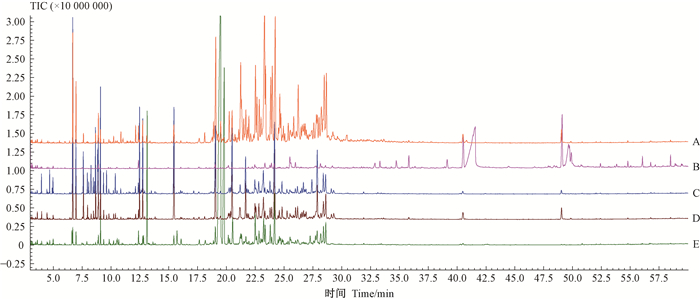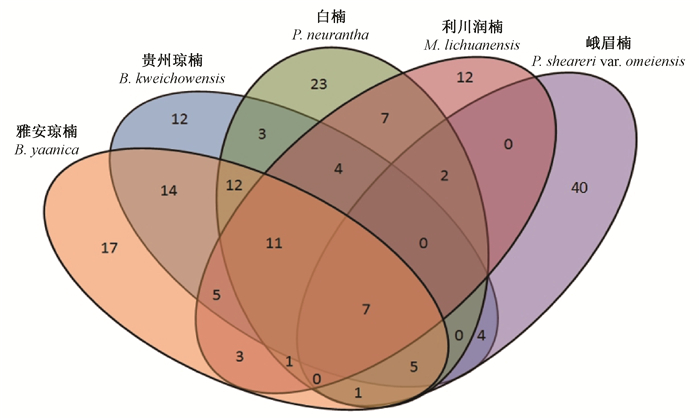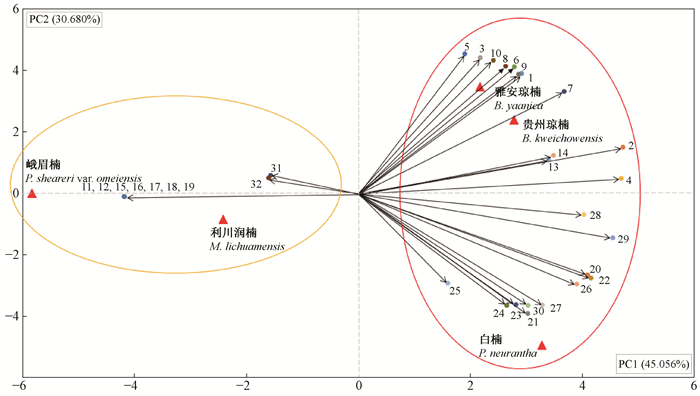文章信息
- 毛运芝, 冯璐璐, 冉慧, 刘世尧.
- Mao Yunzhi, Feng Lulu, Ran Hui, Liu Shiyao.
- 缙云山5种乡土楠木资源叶片精油挥发性成分GC-MS鉴定与组成差异分析
- Identification of Essential Oils and the Volatile Components from Leaves of Five Native Phoebe Plant in Jinyun Mountain by GC-MS
- 林业科学, 2019, 55(2): 182-196.
- Scientia Silvae Sinicae, 2019, 55(2): 182-196.
- DOI: 10.11707/j.1001-7488.20190219
-
文章历史
- 收稿日期:2017-12-18
- 修回日期:2018-03-21
-
作者相关文章
2. 南方山地园艺学教育重点实验室 重庆 400715
2. Key Laboratory of Horticulture Science for Southern Mountainous Regions Ministry of Education Chongqing 400715
楠木是我国传统和珍贵木材,主要来源有樟科(Lauraceae)楠属(Phoebe)和润楠属(Machilus)的一些近缘种,在园林、香料、木材、医药方面均有重要的应用价值(林夏珍,2007;徐振东等,2016)。在传统分类方法中,主要基于经典形态学从花与果性状来区分不同种类,但在楠木及其近缘种中,有些形态特征非常相似,并且有些种类的花果不易得到,楠木类植物物种鉴定与类群划分难度(沈雪梅,2015)。同时国内外学者对润楠属系统分类学研究一直存在众多争议(Kostermans,1952;王玉国等,2003;韦发南等,2006;李朗等,2011),因此建立一种行之有效的亲缘关系鉴定方法对我国楠木类植物资源开发利用具有重要意义。
精油是一类具有芳香气味、在常温下能挥发的油状液体(高锦明,2012),所含组分具有多种生物活性,已成为当前国内外医药化工市场新的需求增长点。樟科植物富含挥发油,是重要的精油生产原料,但其精油成分复杂,目前已经确定的成分高达三百多种,许多学者基于化学组成对樟科植物进行分类(陶光复等,1988;刘虹和等,1992)。李锡文(1975)通过对云南樟(Cinnamomum glandnliferum)及其近缘种植物叶片精油进行研究,证明樟科植物叶片精油组成具有产地差异性,同时在相同区域的樟科植物精油成分也具有一定的特征性。由此可见,精油的挥发性组分也可以作为植物分类的依据,但通过楠木精油成分组成和含量进行分类的研究未见报道。
戴磊等(2013)从同一区域的短序润楠( Machilus breviflora)、浙江润楠(M. chekiangensis)、红楠(M. thunbergii)和凤凰润楠(M. phoenicis)4种润楠属植物鲜叶精油中鉴定出108种挥发性成分,其共有组分为香橙烯、δ-杜松烯、蓝桉醇、α-古芸烯、a-葎草烯、芳樟醇、匙叶桉油烯醇和反式石竹烯,说明近缘植物精油挥发性成分组成具有一定的相似性;王天石等(2017)对荥经、多营、彭州、新津等不同产地的桢楠(Phoebe)木材精油进行分析,发现不同产地精油组分的相对含量差异显著。William等(2007)采用水蒸气蒸馏法对哥斯达黎加的5种琼楠(Beilschmiedia)鲜叶挥发性组分进行研究,结果显示其共有组分仅有α-古巴烯、β-石竹烯、γ-杜松烯、α-葎草烯和大根香叶烯,但组分的含量有很大差异,说明樟科植物叶片精油具有很强的产地差异性。重庆缙云山是我国5 A级植物资源保护区和亚热带常绿阔叶林的典型代表,樟科野生乡土植物资源丰富,但目前对缙云山这一独特生态条件下的楠木类植物资源叶片精油的研究鲜有文献报道。本研究以重庆缙云山常见乡土野生楠木植物资源叶片为材料,进行精油提取和挥发性组分鉴定,探讨其挥发性组分的差异;通过主成分分析和聚类分析,进行亲缘关系鉴定,为乡土野生楠木植物资源分类提供参考。
1 材料与方法 1.1 试验材料所有材料均来自重庆市缙云山国家自然保护区(以下简称缙云山),选择海拔700 m左右、树龄约15年的植株,于2017年7月按代表性原则在植株外围进行采样(表 1)。样品取回后洗净叶片表面灰尘杂质,沥干水分后,剪成1 cm× 1 cm大小备用。
|
|
仪器:AL204万分之一电子天平(瑞士Mettler Toledo公司),Molgene 210a型超纯水机(上海摩尔科学仪器有限公司),KQ5200型超声波清洗器(昆山市超声仪器有限公司),2 000 mL智能恒温电热套(上海越众仪器设备有限公司),2 000 mL磨口圆底烧瓶(深圳市鼎鑫宜实验设备有限公司),2 000 mL精油提取器(郑州科学教研玻璃仪器有限公司,定制),Shimadzu 2010QP Ultra气相色谱-质谱联用仪(日本岛津公司),移液枪及枪头(北京东林昌盛生物科技有限公司),2.5 mL无菌注射器(江西洪达医疗器械集团有限公司),0.45 μm有机微孔滤膜(上海市新亚净化器件厂)。
试剂:超纯水,无水硫酸钠(重庆川东化工(集团)有限公司),石油醚(60~90 ℃)(成都市科龙化工试剂厂),精萘(成都化工试剂厂),均为分析纯。载气为高纯氦气。
1.3 试验方法1) 精油提取与供试品制备 样品叶片精油提取参照史娟(2011)并进行改进。称取洗净、沥干、剪碎后的新鲜叶片样品约500 g,放入2 000 mL圆底烧瓶中,加入重蒸水1 400 mL,采用水蒸气蒸馏法,在125 ℃下微沸回流提取48 h,挥发油提取器分离油水混合物,把分离出的精油用足量无水硫酸钠脱水干燥,得到精油,测定出油率。取精油10 μL,加入5 μL精萘溶液(5 mg·mL-1)做内标,用石油醚(60~90 ℃)定容至1 mL,0.45 μm有机微孔滤膜过滤,AOC-5000 Plus自动进样器进样1 μL,岛津RTX-5MS毛细管色谱柱分离,质谱检测。
2) 精油GC-MS检测 参考任三香等(2005)并进行改进,对5种常见乡土野生楠木植物资源叶片精油进行GC-MS检测。
色谱分离条件:进样口为SPL1,进样加热单元为INJ1。色谱柱为岛津RTX-5MS毛细管色谱柱(30 m× 0.25 mm,0.25 μm),柱箱温度40.0 ℃,进样口温度250 ℃,程序升温(起始温度:40.0 ℃,以6 ℃·min-1的速率升至120 ℃保持2 min,再以3 ℃·min-1的速率升至180 ℃保持10 min,最后以6 ℃·min-1的速率升至260 ℃保持2 min)。载气为He,初始压力为500~900 Pa,流量控制方式为压力控制,总压力为70.2 kPa,总流量为10.0 mL·min-1,柱流量为1.92 mL·min-1,线速度为41 cm·s-1,吹扫流量为3.0 mL·min-1,分流比为-1.0。GC分离时间为60.67 min,得叶片精油总离子流图(TIC)。
质谱检测条件:电离方式为电子轰击电离(EI源);离子源温度为230 ℃;接口温度为230 ℃;溶剂延迟时间为2 min;质谱检测开始时间3.00 min,结束时间60.00 min,采集方式为Scan,间隔时间为0.30 s;扫描速度为3 333 amu·s-1;质量扫描范围为45~800 m·z-1。
1.4 数据处理与分析样品精油经过岛津GC-MS 2010 Plus分离后,采用计算机谱库(NIST08/08S/WILEY)定性,内标法定量,得出各化学组分和含量。应用SPSS 19.0软件对5种乡土野生楠木植物资源叶片精油挥发性组分进行主成分分析(PCA)和聚类分析(HCA),通过聚类分析图直观的表达缙云山5种乡土野生楠木植物资源间的亲缘关系。
2 结果与分析 2.1 叶片精油含量水蒸汽蒸馏法进行叶片精油提取,结果表明:白楠叶片精油提取率为0.313 5%,峨眉楠为0.003 6%,雅安琼楠为0.096 4%,贵州琼楠为0.075 3%,利川润楠为0.070 7%;白楠出油率最高,雅安琼楠次之,峨眉楠最低,白楠是峨眉楠的87倍。5种常见乡土野生楠木植物资源叶片精油含量差异明显,白楠相对较高,琼楠和润楠相对较低,峨眉楠最低。
|
|
岛津RTX-5MS毛细管色谱柱分离,质谱检测,得出叶片精油总离子流图(TIC)(图 1)。白楠共分离出挥发性成分78种,峨眉楠62种,雅安琼楠79种,贵州琼楠79种,利川润楠54种。琼楠属叶片精油挥发性组分最多,楠属次之,润楠属最少;峨眉楠叶片精油出峰时间最早,结束时间最晚;利川润楠结束时间最早,挥发性组分种类最少。

|
图 1 不同乡土野生楠木植物资源叶片的挥发性组分(TIC) Fig. 1 The Total Ion Chromatogram (TIC) of the volatile compositions from different native Phoebe plant resources A:白楠P. neurantha; B:峨眉楠P. sheareri var. omeiensis;C:雅安琼楠B. yaanica;D:贵州琼楠B. kweichowensis;E:利川润楠M. lichuanensis. |
1) 样品叶片精油挥发性成分组成 通过对重庆缙云山5种乡土野生楠木植物资源叶片精油挥发性成分的GC-MS分析,得出其组分表(表 3)。从5种叶片精油中共鉴定出挥发性组分187种,包括烯烃类49种、醇类46种、酯类22种、烷烃类17种、醛类16种、萘类10种、酮类9种、有机酸8种、苯类3种,其他7种。其中白楠共检出78种,峨眉楠62种,雅安琼楠79种,贵州琼楠79种,利川润楠54种;共有性组分7种,分别为D-苎烯、古巴烯、γ-依兰油烯、α-依兰油烯、去氢白菖烯、δ-卡迪烯和α-杜松醇,包括烯烃类6种、醇类1种。
|
|
楠属中,白楠含量最高的挥发性组分为喇叭烯(2.911 00 μg·g-1),其次为δ-卡迪烯(2.043 45 μg·g-1),最低为(3R-反式)-4-乙烯基-4-甲基-3-(1-甲基乙烯基)-1-(1-甲基乙基)-环己烯(0.023 43 μg·g-1);峨眉楠含量最高为正十六烷酸(0.230 40 μg·g-1),其次为亚油酸(0.076 34 μg·g-1),最低为β-榄香烯(0.000 52 μg·g-1)。琼楠属中,雅安琼楠含量最高为α-蒎烯(1.687 12 μg·g-1),其次为δ-卡迪烯(1.315 95 μg·g-1),最低为绿花白千层醇(0.020 97 μg·g-1);贵州琼楠含量最高为α-蒎烯(1.607 47 μg·g-1),其次为δ-卡迪烯(1.448 69 μg·g-1),最低为(-)-α-人参烯(0.017 75 μg·g-1)。润楠属中,利川润楠含量最高为13-烯十四醛(6.495 71 μg·g-1),其次为十四醛(2.375 39 μg·g-1),最低为1, 3, 3-三甲基-2-氧杂二环[2.2.2]辛烷(0.011 40 μg·g-1)。从表 3中可得出白楠组分含量最高,其次为雅安琼楠,峨眉楠最低;δ-卡迪烯是楠属和琼楠属特有的大量挥发性成分,13-烯十四醛和十四醛是润楠属特有的大量挥发性成分。
2) 样品叶片精油挥发性成分差异分析 为了进一步分析常见楠木植物资源挥发性成分特征,本研究比较了5种乡土野生楠木植物资源叶片精油挥发性成分的异同。由图 2可知,峨眉楠特有挥发性组分最多,达40种,其次为白楠23种,雅安琼楠、贵州琼楠、利川润楠数量相当,分别为17、12和12种;楠属特有挥发性组分1种,琼楠属14种。此外,楠属共有挥发性组分17种,琼楠属57种;5种传统楠木共有挥发性组分7种,分别为D-苎烯、古巴烯、α-依兰油烯、(-)-去氢白菖烯、δ-卡迪烯、γ-依兰油烯和α-杜松醇,这7种组分在各楠木植物资源中含量差异较大,且在3个属间的含量也有不同,可以推断出这种差异决定了乡土野生植物资源香气成分的特异性。

|
图 2 不同传统楠木挥发性成分比较的维恩图 Fig. 2 Venn diagram description of the comparison of violate compounds among different native Phoebe plant resources |
3) 样品叶片精油挥发性组分类别差异分析 为了更好的比较5种乡土野生楠木植物资源叶片精油挥发性组分的差异,按照类别统计出不同植物叶片精油挥发性组分数目和总含量(表 4)。从所含挥发性组分类别上看,贵州琼楠最多,利川润楠最少,其他3种相同。除峨眉楠外,烯烃和醇类是几种乡土野生植物资源叶片中主要挥发性组分。此外,不同乡土野生植物资源叶片精油挥发性组分含量也有较大差异,其中,除峨眉楠和利川润楠外,烯烃和醇也是含量最多的挥发性组分。综合分析不同类别挥发性组分的数目和含量,润楠属植物叶片精油挥发性组分较少,且含量集中在几种醛;楠属和琼楠属挥发性组分种类较多,且白楠、雅安琼楠和贵州琼楠含量相对集中在烯烃,峨眉楠含量则集中在数量较少的几种有机酸。
|
|
采用SPSS 19.0软件对5种乡土野生楠木植物资源叶片精油大量挥发性成分进行主成分分析(PCA),PC1和PC2共解释了75.736%的累计贡献率,把因子载荷图和成分得分图组合,几种乡土野生楠木植物资源明显被划分为2类(图 3)。雅安琼楠、贵州琼楠和白楠3种植物叶片挥发性组分相似,决定这一结果的主要挥发性成分为δ-卡迪烯、α-杜松醇、古巴烯、β-桉叶醇、乙酸龙脑酯和石竹烯等;而峨眉楠和利川润楠较为相似,其主要由正十六烷酸、亚油酸、油酸、十六烷酸甲酯、反式-橙花叔醇和1-(+)-抗坏血酸-2, 6-二十六烷酸酯等挥发性成分决定。

|
图 3 不同乡土野生植物资源叶片挥发性组分的主成分分析 Fig. 3 The Principal Component Analysis(PCA)of volatile component in leaves from native Phoebe plant resources 1:喇叭烯Varidiflorene; 2:δ-卡迪烯δ-Cadinene; 3:α-杜松醇α-Cadinol; 4:古巴烯Copaene; 5:1, 1, 7-三甲基-4-亚甲基-十氢-1H-环丙并[e]薁1, 1, 7-trimethyl-4-methylene-decahydro-1H-Cycloprop[e]azulene; 6:γ-依兰油烯γ-Muurolene; 7:β-桉叶醇β-Eudesmol; 8:(-)-去氢白菖烯(-)-Calamenene; 9:(-)-蓝桉(-)-Globulol; 10:α-依兰油烯α-Muurolene; 11:正十六烷酸n-Hexadecanoic acid; 12:亚油酸Linoleic acid; 13:植醇Phytol; 14:异植醇Phytol; 15:油酸Oleic acid; 16:十六烷酸甲酯Hexadecanoic acid, methyl ester; 17:反式-橙花叔醇trans-Nerolidol; 18:1-(+)-抗坏血酸-2, 6-二十六烷酸酯l-(+)-Ascorbic acid 2, 6-dihexadecanoate; 19:6-[(四氢-2H-吡喃-2-基)氧基]-1-己醇6-[(tetrahydro-2H-pyran-2-yl)oxy]-1-Hexanol, 20:α-蒎烯α-Pinene; 21:乙酸龙脑酯Bornyl acetate; 22:石竹烯Caryophyllene; 23:β-罗勒烯β-Ocimene; 24:4-松油醇Terpineol; 25:α-松油醇α-Terpineol; 26:D-苎烯D-Limonene; 27:邻伞花烃o-Cymene; 28:γ-桉叶醇γ-Eudesmol; 29:Z, Z, Z-1, 5, 9, 9-四甲基-环十一-1, 4, 7-三烯Z, Z, Z-1, 5, 9, 9-tetramethyl-1, 4, 7-Cycloundecatriene; 30:α-桉叶醇α-Eudesmol; 31:13-烯十四醛13-Tetradecenal; 32:十四醛Tetradecenal. |
运用SPSS 19.0软件以5种乡土野生植物资源叶片精油共有挥发性组分为分析变量,采用平方欧氏距离计算准则,进行聚类分析。由图 4可知,5种乡土野生楠木植物资源可以分为3类,第1类包括雅安琼楠和贵州琼楠,第2类包括利川润楠和峨眉楠,白楠单独聚为一类,该结果与传统分类有一定差异。

|
图 4 乡土野生楠木植物资源叶片共有挥发性组分的聚类分析 Fig. 4 The Hierarchical Clustering Analysis(HCA)of common volatile components in leaves from different native Phoebe plant resources |
李阳等(2014)对香樟、琼楠、润楠和白楠叶片精油进行提取,与本研究结果相比,白楠较低(0.14%),琼楠和润楠较高(分别为0.19%、0.16%),这可能与采集时间、提取温度和蒸馏时间有关(马希汉等,2004)。此外,本研究所得5种乡土野生楠木植物资源叶片精油提取率差异明显,可能与样品的遗传背景等因素有关(Figueiredo et al., 2008)。从精油提取率来看,峨眉楠最低,这可能是因为峨眉楠在提取过程中蒸馏水黏度增加导致精油未被分离完全,从而影响了叶片的出油(陈鸿等,2012)。
3.2 叶片精油挥发性组分以往对楠木植物精油挥发性组分的研究主要集中在楠属的桢楠和润楠属上(任维俭等,1990;周妮等,2015;李萧芹,2016;丁文等,2017)。本研究检测到白楠叶片精油的主要成分为喇叭烯、δ-卡迪烯、α-杜松醇和古巴烯,而李阳等(2014)研究结果表明白楠主要含有α-蒎烯、乙酸冰片酯和α-葎草烯,与本研究结果有一定差异。雅安琼楠和贵州琼楠的主要挥发性成分为α-蒎烯和δ-卡迪烯,与前人研究(李阳等,2014;罗思源等,2015)结果基本一致。另一方面,白楠、雅安琼楠和贵州琼楠叶片精油挥发性组分集中在烯烃上,这可能就是其有香味的重要原因(蒋剑波,2001;徐年军等,2006;马慧芬,2011)。利川润楠的挥发性成分主要集中在醛类上,主要有13-烯十四醛和癸醛,与前人结果一致(李阳等,2014),具有天然的醛香(池庭飞,1985)。首次对峨眉楠叶片精油挥发性组成成分进行研究,得出其主要成分集中在几种有机酸,主要包括正十六烷酸和亚油酸,其中正十六烷酸是生产蜡烛、肥皂、润滑脂、软化剂和合成洗涤剂的原料,亚油酸具有降低血脂、软化血管、降低血压、促进微循环的作用,为未来峨眉楠的资源开发提供基础数据。但其鲜叶含油量较低,这也为该物种的资源化利用带来了较大困难。以往研究中对精油挥发性组分的定量都是用面积归一化法表示其相对含量,本研究中采用内标定量法,所得结果更加准确可靠,可体现几者间的差异。
3.3 亲缘关系远近一直以来,樟科植物类群间的界限都含糊不清(李捷等,2004)。有研究表明,琼楠属与厚壳桂属(Cryptocarya)、土楠属(Fndiandra)等属间有着密切的亲缘关系,与楠属分别属于不同的分支(Heo et al., 1998;van der Werff et al., 2001;Chanderbali,2001;Li,2001)。润楠属的属级地位备受争议,Kostermans(1973)、Long(1984)和Chanderbali(2001)等人从形态和分子水平上研究表明,润楠属作为亚属归于鳄梨属(Pyrus)中,而汤庚国(1995)、Li(2001)和陈俊秋(2008, 2009)等认为润楠属为一单系类群,其与楠属的关系较之鳄梨属更为紧密,这个结论与韦发南等(2006)基于形态学研究所得出的结论一致。陈云霞等(2014)对楠木及其近缘属叶绿体matK基因序列聚类分析,结果表明楠属和润楠属聚为1个分支,但matK序列基本可以进行属间鉴定,在种间水平上并不能很好区分。之前的研究主要是针对属及属以上樟科植物进行类别分析,本研究运用植物化学分类方法对物种之间的挥发性成分进行比较分析,认为,雅安琼楠和贵州琼楠聚为一类;峨眉楠和利川润楠聚为一类;白楠明显不同于其他几种,单独聚为一类。虽然植物的化学分类不能替代传统的植物分类,但可以作为一种重要的补充或信息源,为乡土野生植物资源分类提供理论参考。
4 结论1) 白楠出油率最高,雅安琼楠次之,峨眉楠最低;2)共检测出挥发性成分187种,共有成分却只有7种,分别为D-苎烯、古巴烯、γ-依兰油烯、α-依兰油烯、去氢白菖烯、δ-卡迪烯和α-杜松醇,含量差异较大;3)叶片精油挥发性成分分类学研究结果表明,5种乡土野生楠木植物资源可分为3类,其中雅安琼楠和贵州琼楠聚为一类,峨眉楠和利川润楠聚为一类,白楠明显不同于其他几种,单独聚为一类。
陈鸿, 梁国平, 沈宏伟. 2012. 5种樟属植物叶片精油提取研究. 宁夏农林科技, 53(4): 79-81. (Chen H, Liang G P, Shen H W. 2012. Analysis on essential oil extraction of several plants leaf of Cinnamomum Trew. Ningxia Journal of Agriculture and Forestry Science and Technology, 53(4): 79-81. [in Chinese]) |
陈俊秋. 2008.樟科润楠属植物系统学研究.西双版纳: 中国科学院研究生院(西双版纳热带植物园)硕士学位论文. (Chen J Q. 2008. A phylogenetic study on the genus Machilus Nees(Lauraceae). Xishuangbanna: MS thesis of Xishuangbanna Tropical Botanical Garden, Chinese Academy of Sciences.[in Chinese]) http://cdmd.cnki.com.cn/Article/CDMD-80128-2008161515.htm |
陈俊秋, 李朗, 李捷, 等. 2009. 樟科润楠属植物ITS序列贝叶斯分析及其系统学意义. 云南植物研究, 31(2): 117-126. (Chen J Q, Li L, Li J, et al. 2009. Bayesian inference of nrDNA ITS sequences from Machilus (Lauraceae) and its systematic significance. Acta Botanica Yunnanica, 31(2): 117-126. [in Chinese]) |
陈云霞, 南程慧, 薛晓明. 2014. 楠木种属及其近缘属叶绿体matK基因序列的鉴定. 贵州农业科学, 42(2): 27-31. (Chen Y X, Nan C H, Xue X M. 2014. Identification of chloroplast matK sequence of Phoebe and its related genera. Guizhou Agricultural Science, 42(2): 27-31. [in Chinese]) |
池庭飞, 施小芳, 袁湘宁, 等. 1985. 刨花楠叶精油化学成分的初步研究. 福建林学院学报, 5(2): 37-39. (Chi T F, Shi X F, Yuan X N, et al. 1985. A preliminary study on the chemical constituents of essential oil from the leaves of Machilus pauhoi Kanehira. Journal of Fujian College of Forestry, 5(2): 37-39. [in Chinese]) |
戴磊, 冯志坚, 李文峰. 2013. 4种润楠属植物精油成分分析. 福建林业科技, 40(1): 49-51. (Dai L, Feng Z J, Li W F. 2013. Component analysis of essential oil from 4 kinds of Machilus plants. Jour of Fujian Forestry Science and Technology, 40(1): 49-51. [in Chinese]) |
丁文, 宁莉萍, 杨威, 等. 2017. 桢楠精油、精气化学成分及精油生物活性研究. 西北农林科技大学学报:自然科学版, 45(9): 123-128. (Ding W, Ning L P, Yang W, et al. 2017. Study on chemical compositions of phytoncidere and essential oil and bioactivity of essential oil from Phoebe zhennan. Journal of Northwest Agriculture and Forestry University:Natural Science Edition, 45(9): 123-128. [in Chinese]) |
高锦明. 2012. 植物化学. 2版. 北京: 科学出版社, 223. (Gao J M. 2012. Phytochemistry. Second Edition. Second Edition. Beijing: Science Press, 223. [in Chinese]) |
蒋剑波. 2001. 毛细管气相色谱法分析柏木精油中萜烯成分. 吉首大学学报:自然科学版, 22(3): 92-93. (Jiang J B. 2001. Analysis of terpene components in the essential oil of Cedarwood with capillary gas chromatography. Journal of Jishou University:Natural Science Edition, 22(3): 92-93. [in Chinese]) |
李捷, 李锡文. 2004. 世界樟科植物系统学研究进展. 云南植物研究, 26(1): 1-11. (Li J, Li X W. 2004. Advances in Lauraceae systematic research on the world scale. Acta Botanica Yunnanica, 26(1): 1-11. [in Chinese]) |
李朗, 李捷, 李锡文. 2011. 国产樟科楠属五种植物之分类修订. 植物分类与资源学报, 33(2): 157-160. (Li L, Li J, Li X W. 2011. Taxonomic revision of five species of the genus Phoebe(Lauraceae) from China. Plant Diversity and Resources, 33(2): 157-160. [in Chinese]) |
李箫芹. 2016.刨花润楠苗期性状地理变异及种源间叶精油化学成分研究.广州: 华南农业大学硕士学位论文. (Li X Q. 2016. Study on the chemical constituents of the essential oil from leaf of Machilus paunoi Kanenira seedling traits and geographic variation among provenances. Guangzhou: MS thesis of South China Agricultural University.[in Chinese]) http://cdmd.cnki.com.cn/Article/CDMD-10564-1016922362.htm |
李锡文. 1975. 云南樟及其相近种的精油化学与植物分类. 植物分类学报, 13(4): 35-50. (Li X W. 1975. The relation between plant classification and chemistry of essential oil in Cinnamomum glandnliferum(Wall.) Nees and its allies. Aeta Phytotoax-nomica Sinica, 13(4): 35-50. [in Chinese]) |
李阳, 江广渝, 王海洋. 2014. 4种樟科园林树种挥发性物质杀菌能力测定及有效成分分析. 西南师范大学学报:自然科学版, 39(6): 29-34. (Li Y, Jiang G Y, Wang H Y. 2014. On analysis of bactericidal ability and effective component of four garden trees. Journal of Southwest China Normal University:Natural Science Edition, 39(6): 29-34. [in Chinese]) |
林夏珍. 2007. 浙江润楠属植物的数量分类. 林业科学, 43(11): 151-156. (Lin X Z. 2007. Quantitative classification of plants of Machilus in Zhejiang province. Scientia Silvae Sinicae, 43(11): 151-156. [in Chinese]) |
刘虹, 沈美英. 1992. 广西樟树叶油的五种生化类型. 广西林业科学, 21(4): 46-51. (Liu H, Shen M Y. 1992. Five biochemical types of Cinnamomum camphora leaf oil in Guangxi province. Guangxi Forest Science and Technology, 21(4): 46-51. [in Chinese]) |
罗思源, 刘世尧, 卞京军, 等. 2015. 雅安琼楠鲜叶挥发油成分的GC-MS分析. 西南大学学报:自然科学版, 37(3): 166-172. (Luo S Y, Liu S Y, Bian J J, et al. 2015. GC-MS analysis of the components of volatile oils from the fresh leaves of Beilschmiedia yaanica. Journal of Southwest University:Natural Science Edition, 37(3): 166-172. [in Chinese]) |
马惠芬, 司马永康, 郝佳波, 等. 2011. 多脉含笑和醉香含笑挥发油的化学成分研究. 广东农业科学, 38(23): 110-113. (Ma H F, Sima Y K, Hao J B, et al. 2011. Study on chemical components in the volatile oils from Michelia polyneura C.Y. Wu ex Law et Y.F. Wu. and Michelia macclurei Dandy. Guangdong Agricultural Sciences, 38(23): 110-113. [in Chinese]) |
马希汉. 2004. 玫瑰精油提取工艺研究. 林产化学与工业, 24(s1): 80-84. (Ma X H. 2004. Study on processing technology of rose essential oil. Chemistry and Industry of Forest Products, 24(s1): 80-84. [in Chinese]) |
任三香, 王发松, 陆慧宁. 2005. 山胡椒叶挥发油的GC-MS分析. 分析测试学报, 24(s1): 101-102. (Ren S X, Wang F S, Lu H N. 2005. GC-MS analysis of essential oil extracted from laves of Lindera glauca. Journal of Instrumental Analysis, 24(s1): 101-102. [in Chinese]) |
任维俭, 温鸣章, 肖顺昌, 等. 1990. 楠木种皮精油化学成分的研究. 天然产物研究与开发, 2(3): 59-62. (Ren W J, Wen M Z, Xiao S C, et al. 1990. Studies on chemical components of the essential oil from the peel of Phoebe zhennan. Natural Product Research and Development, 2(3): 59-62. [in Chinese]) |
沈雪梅. 2015. 17种樟科润楠属植物的数量分类与分子分类研究.上海: 华东师范大学硕士学位论文. (Shen X M. 2015.Study on numerical taxonomy and molecular taxonomy of 17 species of Machilus Nees(Lauraceae). Shanghai: MS thesis of East China Normal University.[in Chinese]) http://cdmd.cnki.com.cn/Article/CDMD-10269-1015345563.htm |
史娟. 2011. 香樟叶中精油的提取. 江苏调味副食品, 28(2): 16-19. (Shi J. 2011. The extraction of essential oil from the Cinamomum camphorastem leaves. Jiangsu Condiment and Subsidiary Food, 28(2): 16-19. [in Chinese]) |
汤庚国, 向其柏. 1995. 樟科植物花粉形态研究. 植物分类学报, 33(2): 161-170, 209-213. (Tang G G, Xiang Q B. 1995. Pollen morphology of the family Lauraceae in China. Aeta Phytotaxonomica Sinica, 33(2): 161-170, 209-213. [in Chinese]) |
陶光复, 钟扬. 1988. 湖北樟属数量化学分类研究. 中国科学院大学学报, 26(6): 409-417. (Tao G F, Zhong Y. 1988. Study on numerical chemotaxonomy of Cinnamomum in Hubei province. Journal of University of Chinese Academy of Sciences, 26(6): 409-417. [in Chinese]) |
王天石, 时浩, 陶相宇, 等. 2017. 基于GC-MS技术的桢楠化学辅助鉴定. 东北林业大学学报, 45(6): 57-60. (Wang T S, Shi H, Tao X Y, et al. 2017. Chemical assistant identification of Phoebe zhennan by GC-MS. Journal of Northeast Forestry University, 45(6): 57-60. [in Chinese]) |
王玉国, 韦发南. 2003. 樟科两个近缘属润楠属和楠木属花粉形态的比较研究. 广西植物, 23(1): 27-30, 96-99. (Wang Y G, Wei F N. 2003. Comparative study of pollen morphology in Machilus and its related genus Phoebe under SEM. Guihaia, 23(1): 27-30, 96-99. [in Chinese]) |
韦发南, 唐赛春. 2006. 关于樟科润楠属和鳄梨属的分类界线问题. 植物分类学报, 44(4): 437-442. (Wei F N, Tang S C. 2006. On the circumscription of Machilus and of Persea (Lauraceae). Acta Phytotaxonomica Sinica, 44(4): 437-442. [in Chinese]) |
徐年军, 白海波, 严小军, 等. 2006. 山腊梅中挥发油成分分析. 分析测试学报, 25(1): 90-93. (Xu N J, Bai H B, Yan X J, et al. 2006. Analysis of volatile components in essential oil of Chimonanthus nitens by capillary Gas Chromatography-Mass Spectrometry. Journal of Instrumental Analysis, 25(1): 90-93. [in Chinese]) |
徐振东, 杨曼, 胡蝶, 等. 2016. 润楠属主要树种的资源状况、研究现状和开发利用前景. 长江大学学报:自科版, 13(3): 13-17. (Xu Z D, Yang M, Hu D, et al. 2016. Resource situation, research status and development utilization prospects of Machilus Nees main tree species. Journal of Yangtze University:Natural Science Edition, 13(3): 13-17. [in Chinese]) |
周妮, 齐锦秋, 王燕高, 等. 2015. 桢楠现代木和阴沉木精油化学成分的GC-MS分析. 西北农林科技大学学报:自然科学版, 43(6): 136-140. (Zhou N, Qi J Q, Wang Y G, et al. 2015. GC-MS analysis of chemical components of essential oils from recent and ancient buried Phoebe zhennan woods. Journal of Northwest Agriculture and Forestry University:Natural Science Edition, 43(6): 136-140. [in Chinese]) |
Chanderbali A S, Henk V D W, Renner S S. 2000. Phylogeny and historical biogeography of Lauraceae. Annals of the Missouri Botanical Garden, 88(1): 104-134. |
Figueiredo A C, Barroso J G, Pedro L G, et al. 2008. Factors affecting secondary metabolite production in plants:volatile components and essential oils. Flavour & Fragrance Journal, 23(4): 213-226. |
Werff H V D. 2001. An annotated key to the genera of Lauraceae in the flora Malesiana region. Blumea Journal of Plant Taxonomy & Plant Geography, 46(1): 125-140. |
Heo K, Werff H V D, Tobe H. 2010. Embryology and relationships of Lauraceae (Laurales). Botanical Journal of the Linnean Society, 126(4): 295-322. |
Kostermans A J G H. 1952. Historical survey of the Lauraceae. Journal of Scientific Research (Indonesia), 1: 83-95. |
Kostermans A J G H. 1973. Synopsis of Alseodaphne Nees (Lauraceae). Candollea.
|
Li J. 2001. Systematic relationships within the Litsea complex (Lauraceae). PhD thesis of Department of Environmental Biology University of Adelaide.
|
Long D G. 1984. Notes relating to the flora of Bhutan. Ⅷ.. Lauraceae. Notes-Royal Botanic Garden Edinburgh.
|
William N S, William A H. 2007. Leaf essential oil composition of five species of Beilschmiedia from Monteverde, Costa Rica. Natural Product Communications, 2(1): 79-83. |
 2019, Vol. 55
2019, Vol. 55

